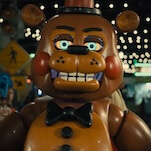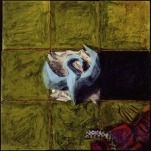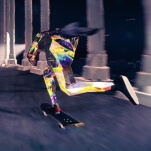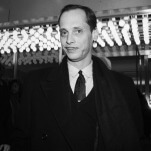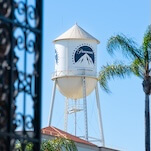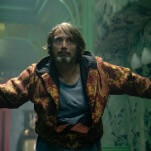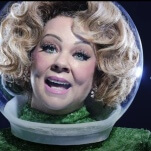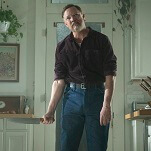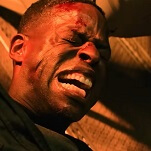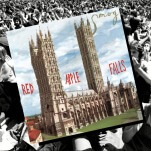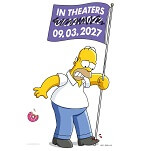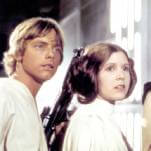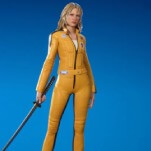Eddie Murphy’s Sleepy Years Case File #171: The Adventures Of Pluto Nash
Eddie Murphy’s career is a quiet tragedy. He’s managed to steer clear of many of the traps that ensnare superstars—drugs, alcohol, violent rages, jail, nervous breakdowns, a compulsion toward self-destruction—only to become a victim of his own apathy and ruthless lack of creative ambition. It’s the saga of an almost preternaturally gifted young performer who has found myriad ways to squander his prodigious talent. “President Orders Brando To Gain 250 Pounds: Star’s Raw Sexuality Too Dangerous at Present Weight, Ike Says” screams a headline from The Onion’s Our Dumb Century. The idea, of course, is that Brando was too impossibly pretty and virile for the buttoned-up world of 1950s America. I feel the same way about the young Eddie Murphy. Only Murphy didn’t get fat or go crazy; he just got lazy.
There was a time, however, when Murphy was almost too perfect. He’s been a bland fixture of sub-mediocre family entertainment for so long that it can be easy to forget what an electrifying, original presence he was at the beginning of his career. When he debuted on Saturday Night Live at 19 in 1980, he boasted a confidence and polish years beyond his age. He was stunningly handsome, a gifted improviser, and confident enough in his sexuality to strut around in a tight red leather suit while making homophobic jokes. He did amazing impressions, and boasted both a million-dollar smile and the world’s most distinctive, infectious laugh.
Murphy got so big so fast that he became the first—and to date, only—Not Ready For Prime Time Player to host the show while he was still a cast member. Saturday Night Live quickly became The Eddie Murphy Show, Featuring Joe Piscopo And Some Other Guys. Murphy’s unstoppable momentum carried over to the critical and commercial hits 48 Hours, Trading Places, and Beverly Hills Cop. The world prostrated itself before him, and he was one of the most famous people in the world.
But after the failure of his 1989 directorial debut, Harlem Nights, Murphy seemed to stop trying. The manic energy of his early films and Saturday Night Live stint gave way to a glazed indifference. On a profound level, Murphy just didn’t seem to care. Inertia, crass commercial calculation, and naked greed ruled his career. He had apparently ceded control of his life to his accountant, though we all know those matters are handled better and more efficiently by the good people over at the Church Of Scientology.
Murphy set his personal bar so low that he was praised to the high heavens every time he exerted himself past the least possible effort. He was praised for uncharacteristically not phoning it in while playing a dual role as both an Eddie Murphy-like movie star and his hapless look-alike in Bowfinger. He was pegged as a surefire Oscar-winner for his performance as a James Brown surrogate in Dreamgirls. (Then, a little movie called Norbit presumably made the Academy think, “You know, on second thought, maybe Alan Arkin would be a better choice after all.”)
Great entertainers like James Brown, Lenny Bruce, or Murphy’s hero, Richard Pryor, gave audiences everything. They gave too much, by exposing themselves spiritually and creatively every time they performed. That’s what made them dangerous and alive. Murphy’s problem is that he gives audiences nothing of himself. Like Peter Sellers and Mike Myers, Murphy is a chameleon comfortable in any skin except his own. At the beginning of his career, having Murphy play multiple roles in the same film was a smart way to illustrate his astonishing versatility. These days, Murphy’s array of fat suits, wigs, and silly voices feel like crutches for an actor afraid to expose his true self, because he suspects that there’s nothing underneath all the makeup and padding.
I was flipping through channels a while back—technically, channel-surfing, but I think that phrase should be stricken from the English language—and I stumbled across Murphy on whatever program Jay Leno was hosting at the time. Murphy was promoting, I dunno, fucking Shrek 4 or some such slop, and I was struck by how incredibly artificial and scripted everything he said felt. It was as if Murphy was reduced to doing a half-assed impression of himself. The famous laugh rang hollow; it sounded more obligatory than joyful. He flashed the radiant smile gratuitously and defensively. Simply put, there was no there there. My response was similar to Christian Bale’s when he saw Tom Cruise on a talk show and realized that this terrifying, overly ingratiating simulacrum of a human being would inspire his revelatory lead performance in American Psycho.
Murphy’s decades-long descent into homogeneous dreck reached its nadir when he somehow stayed awake just long enough to star in The Adventures Of Pluto Nash, one of the biggest box-office failures in film history. The film spent two long years on a studio shelf before being unleashed on the public. The numbers are staggering: Pluto Nash cost $100 million to make and another $20 million to market, yet grossed only $7 million. Worldwide. As in, everywhere in the entire world.
The Adventures Of Pluto Nash traveled a long, circuitous road to phenomenal failure. The original screenplay was written in the mid-1980s and re-written countless times by script doctors. This boggles the mind. What in the original screenplay could have been promising or commercial enough to make the studio continue to develop it for decades? Was the concept of a science-fiction comedy about a club owner on the moon so inherently brilliant that it needed to be brought to the big screen at any cost?


